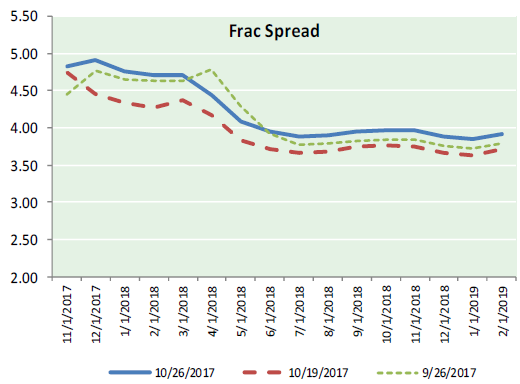
Nat Gas News – October 27, 2017
Nat Gas News – October 27, 2017
Note: Due to a change in ICE’s policy regarding the distribution of data, starting November 1st, the Mansfield Natural Gas Newsletter will no longer provide the Physical Spot Natural Gas Price map typically found on page (2) two. We apologize for any inconvenience that this may cause. The Spot Price map will be the only aspect of the NGN that will change and our commitment to serve accurate and relevant Natural Gas News will continue. Please do not hesitate to reach out to us at info@mansfieldoil.com with any questions.
Michigan Forecast to Return to Normal Winter Temps, yet Natural Gas Prices Expected to Remain Near Historic Lows
Business Insider reports: DETROIT, Oct. 27, 2017 /PRNewswire/ — A more typical Michigan winter is expected this year, in contrast to last year’s unseasonable warmer winter temperatures. As the cold weather sets in, DTE Energy is advising Michigan residents to start planning now for colder temperatures and the resulting increased use of natural gas. DTE encourages customers to take proactive measures to reduce their natural gas usage by installing programmable thermostats, increasing insulation and weatherproofing drafty air leaks to stay warm and comfortable this winter. If Michigan does experience a typical winter, DTE customers in southeast Michigan will spend, on average, $20 to $30 more over the six-month heating season compared to the same six months last year. This number could vary across the state in different temperate regions.
Marathon Oil Gets Permission to Flare Natural Gas from 21 Wells
Prairie Public reports: North Dakota’s Industrial Commission has given Marathon Oil permission to flare natural gas from 21 oil wells in Dunn County. The wells are close to the Bear Creek natural gas processing plant. But state Mineral Resources director Lynn Helms said the 21 are older wells, and they produce hydrogen sulfide. “The Bear Creek plant is not designed to process hydrogen sulfide,” Helms told the Commission. “It’s designed to process sweet Bakken gas.” Helms said if the wells are going to continue to safely produce crude, the gas needs to be flared. “That’s so that the hydrogen sulfide is burned, and doesn’t represent a public health and safety hazard,” Helms said.
This article is part of Uncategorized
Tagged:
MARKET CONDITION REPORT - DISCLAIMER
The information contained herein is derived from sources believed to be reliable; however, this information is not guaranteed as to its accuracy or completeness. Furthermore, no responsibility is assumed for use of this material and no express or implied warranties or guarantees are made. This material and any view or comment expressed herein are provided for informational purposes only and should not be construed in any way as an inducement or recommendation to buy or sell products, commodity futures or options contracts.







